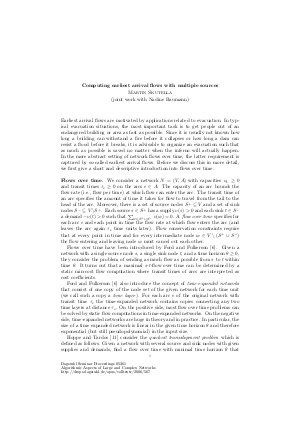Computing earliest arrival flows with multiple sources
Authors Nadine Baumann, Martin Skutella
-
Part of:
Volume:
Dagstuhl Seminar Proceedings, Volume 5361
Part of: Series: Dagstuhl Seminar Proceedings (DagSemProc) - License:
 Creative Commons Attribution 4.0 International license
Creative Commons Attribution 4.0 International license
- Publication Date: 2006-05-08
File

PDF
DagSemProc.05361.4.pdf
- Filesize: 125 kB
- 3 pages
Document Identifiers
Subject Classification
Keywords
- Networks
- flows over time
- dynamic flows
- earliest arrival
- evacuation
Metrics
- Access Statistics
-
Total Accesses (updated on a weekly basis)
0Document
0Metadata
Abstract
Earliest arrival flows are motivated by applications related to evacuation. Given a network with capacities and transit times on the arcs, a subset of source nodes with supplies and a sink node, the task is to send the given supplies from the sources to the sink "as quickly as possible". The latter requirement is made more precise by the earliest arrival property which requires that the total amount of flow that has arrived at the sink is maximal for all points in time simultaneously. It is a classical result from the 1970s that, for the special case of a single source node, earliest arrival flows do exist and can be computed by essentially applying the Successive Shortest Path Algorithm for min-cost flow computations. While it has previously been observed that an earliest arrival flow still exists for multiple sources, the problem of computing one efficiently has been open. We present an exact algorithm for this problem whose running time is strongly polynomial in the input plus output size of the problem.
Cite As Get BibTex
Nadine Baumann and Martin Skutella. Computing earliest arrival flows with multiple sources. In Algorithmic Aspects of Large and Complex Networks. Dagstuhl Seminar Proceedings, Volume 5361, pp. 1-3, Schloss Dagstuhl – Leibniz-Zentrum für Informatik (2006)
https://doi.org/10.4230/DagSemProc.05361.4
BibTex
@InProceedings{baumann_et_al:DagSemProc.05361.4,
author = {Baumann, Nadine and Skutella, Martin},
title = {{Computing earliest arrival flows with multiple sources}},
booktitle = {Algorithmic Aspects of Large and Complex Networks},
pages = {1--3},
series = {Dagstuhl Seminar Proceedings (DagSemProc)},
ISSN = {1862-4405},
year = {2006},
volume = {5361},
editor = {Stefano Leonardi and Friedhelm Meyer auf der Heide and Dorothea Wagner},
publisher = {Schloss Dagstuhl -- Leibniz-Zentrum f{\"u}r Informatik},
address = {Dagstuhl, Germany},
URL = {https://drops.dagstuhl.de/entities/document/10.4230/DagSemProc.05361.4},
URN = {urn:nbn:de:0030-drops-5672},
doi = {10.4230/DagSemProc.05361.4},
annote = {Keywords: Networks, flows over time, dynamic flows, earliest arrival, evacuation}
}
